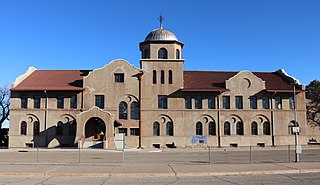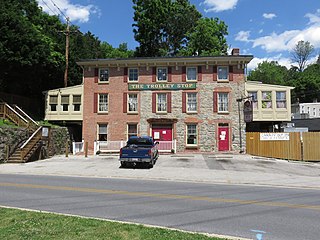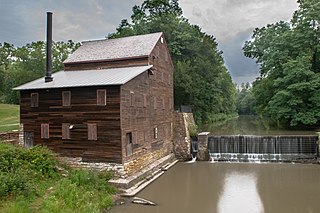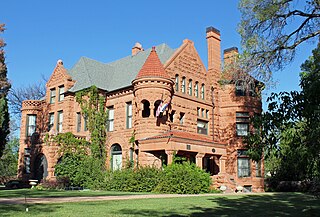
Brandywine Creek is a tributary of the Christina River in southeastern Pennsylvania and northern Delaware in the United States. The Lower Brandywine is 20.4 miles (32.8 km) long and is a designated Pennsylvania Scenic River with several tributary streams. The East Branch and West Branch of the creek originate within 2 miles (3 km) of each other on the slopes of Welsh Mountain in Honey Brook Township, Pennsylvania, about 20 miles (32 km) northwest of their confluence.

Hovenweep National Monument is located on land in southwestern Colorado and southeastern Utah, between Cortez, Colorado and Blanding, Utah on the Cajon Mesa of the Great Sage Plain. Shallow tributaries run through the wide and deep canyons into the San Juan River.

Hubbell Trading Post National Historic Site is a historic site on Highway 191, north of Chambers, with an exhibit center in Ganado, Arizona. It is considered a meeting ground of two cultures between the Navajo and the settlers who came to the area to trade.

Ironstone is an historic village,, in the township of Uxbridge, Massachusetts, United States. It derived its name from plentiful bog iron found here which helped Uxbridge to become a center for three iron forges in the town's earliest settlement. South Uxbridge has historic sites, picturesque weddings, hospitality, industrial and distribution centers, and the new Uxbridge High School. This community borders North Smithfield, and Burrillville, Rhode Island, and Millville, Massachusetts. South Uxbridge receives municipal services from Uxbridge, for fire, police, EMS, School district, public works, and other services. There is a South Uxbridge fire station of the Uxbridge fire department. Worcester's Judicial District includes Uxbridge District Court. Ironstone appears on the Blackstone U.S. Geological Survey Map. Worcester County is in the Eastern time zone and observes DST.

Arvada Flour Mill, also known as Tiller's Moving & Storage, Inc. is a vacant flour mill in Arvada, Colorado, that is or was owned by Tiller's Moving & Storage, Inc. It was listed on the National Register of Historic Places in 1975. The Arvada Historical Society owns the mill and provides tours of the Arvada Flour Mill Museum by appointment.

The Minnequa Steel Works Office Building and Dispensary are historic buildings in Pueblo, Colorado. The main office building served as headquarters of Colorado Fuel and Iron Company. The medical dispensary building served as a medical clinic for treatment of minor injuries and illnesses, and in later years, as both clinic and personnel office for the Colorado Fuel and Iron Company. Opened in 1902, the six-room Spanish Mission style building contained waiting, drug, consultation, surgical and storage rooms, in addition to sleeping and office quarters for attending physicians. In 1902, as the company payroll exceeded 5,000 employees, the Dispensary handled an average of seventy-five cases daily. As employee numbers grew, medical staff also began treating families of employees. The building was used as a medical building for mill employees until the early 1990s. The Minnequa Steelworks Office Building, built in 1901, served as company headquarters until the early 1990s. Here, many office functions occurred including purchasing, finance, payroll, engineering, and other administrative functions. The building complex was listed on the National Register of Historic Places in 2002, amended to the National Level of Significance of the National Register of Historic Places in 2008, and was designated a National Historic Landmark in 2021. Owned and operated by the Steelworks Center of the West, the medical dispensary building is the home of the Steelworks Museum of Industry and Culture, which opened on January 19, 2007. The museum's exhibits include the local history of coal mining, steel production, railroads, labor, and the impact of the Colorado Fuel and Iron Company on the region. The main administration building will serve as the second phase of the Steelworks Museum of Industry and Culture in the coming years.

The Sheridan Flouring Mills, also known as the Mill Inn, are an industrial complex in Sheridan, Wyoming. The mills were a major component of the economy of north central Wyoming, providing collection, storage and milling of locally produced wheat and other grains into flour and other milled products. The original mill was established by Captain Scott W. Snively in the early 1890s. The Sheridan Milling and Manufacturing Company was sold to J.W. Denio in 1903, who operated the mill at its location on Broadway Avenue near downtown Sheridan. A catastrophic fire destroyed this mill in 1919, resulting in the purchase of a new location on Coffeen Avenue and construction of a much larger mill.

Ellicott's Mills Historic District is a national historic district at Oella, Baltimore County, Maryland, United States. It is on the east bank of the Patapsco River, opposite Ellicott City. This historic district designation relates to the industrial operations of the Ellicott family from the 1770s through the mid-19th century. It consists of the sites of historic buildings including: an 18th-century building, a section of an 18th-century mill incorporated in a 20th-century factory, a 19th-century tavern, 19th-century workers housing, and an 1859 Italianate villa built by John Ellicott. Historically, these industrious mills were served by the major east–west route in Maryland during the early 19th century, the old National Pike. Also in the district is the mammoth multi-story Wilkins-Rogers Company flour plant, which is located on the site of the 1792 Ellicott Flour Mill, the first merchant flour mill in the United States.

Farmington Historic District is the town center of Farmington, Michigan. It was listed on the National Register of Historic Places in 1976. The area roughly corresponds to the section of Grand River Avenue and Shiawassee Avenue from Warner Street to junction of Grand River and Shiawassee.

The Newlin Mill Complex, also referred to as The Newlin Grist Mill, is a water-powered gristmill on the west branch of Chester Creek near Concordville, Pennsylvania was built in 1704 by Nathaniel and Mary Newlin and operated commercially until 1941. During its three centuries of operation, the mill has been known as the Lower Mill, the Markham Mill, the Seventeen-O-Four Mill and the Concord Flour Mill. In 1958 the mill property was bought by E. Mortimer Newlin, restored and given to the Nicholas Newlin Foundation to use as a historical park. Water power is still used to grind corn meal which is sold on site. The park includes five historical buildings, which were added to the National Register of Historic Places in 1983, and 150 acres (61 ha) of natural woodland.

The Union Avenue Historic Commercial District is a century-old business district in Pueblo, Colorado, United States. The district comprises sixty-nine contributing properties in a total area of 27 acres (11 ha) including the Union Depot, Vail Hotel and Quaker Flour Mill. In 1983, the district was listed on the National Register of Historic Places. The historic district was originally located within South Pueblo and Central Pueblo, two small cities until incorporated into Pueblo, Colorado which combined South Pueblo, Central Pueblo, Pueblo and Bessemer into one municipality. While still South Pueblo, Bat Masterson, best known for his association with Wyatt Earp and Doc Holliday was brought in as sheriff to protect a railroad that was being built.

The Charles H. Stickney House in Pueblo, Colorado, USA, was built in 1890. It was designed by New York architect William Halsey Wood, and Pueblo architect Frederick Albert Hale supervised its construction.

The IOOF Building in Ashland, Oregon, also known as Oddfellows Building, is a two-story eclectic-styled building in "The Plaza" area of Ashland that was built in 1879. Historically its second story served as a clubhouse of the local International Order of Odd Fellows chapter and the ground floor provided specialty store space. It was listed on the National Register of Historic Places in 1978, for its architecture. From its construction to 1978, the building had served well in the active "Plaza" area of Medford, and continued in its original purposes. Behind the building, by 1978 there was a landscaped park area which had been extended from nearby Lithia Park, where there was once a mill flume.

Pine Creek Gristmill is a historic building located in Wildcat Den State Park in Muscatine County, Iowa, United States. The building was listed on the National Register of Historic Places in 1979.

Sunrise was a company mining town of the Colorado Fuel and Iron Company located in Platte County, Wyoming, United States. The entire site of the former mining district and town is listed on the National Register of Historic Places.

Walnut Ridge Friends Meetinghouse is a historic Quaker meeting house located in Ripley Township, Rush County, Indiana. It was built in 1866, and is a one-story, vernacular Italianate style brick building with a moderately pitched gable roof. It features a projecting octagonal entrance bay added in 1890 at the time of an extensive renovation. The building was remodeled in 1972 and a fellowship room addition constructed in 1976. The Walnut Ridge Meeting was established in 1827.
The Brigham City Co-op was one of the most successful cooperative enterprises of the Mormons in Utah.

The Abenicio Salazar Historic District, on Camino del Pueblo in Bernalillo, New Mexico, was listed on the National Register of Historic Places in 1980. The listing included 13 contributing buildings on 9 acres (3.6 ha).

The Orman-Adams House, at 102 W. Orman Ave. in Pueblo, Colorado, was built in 1890. It was listed on the National Register of Historic Places in 1976.




















